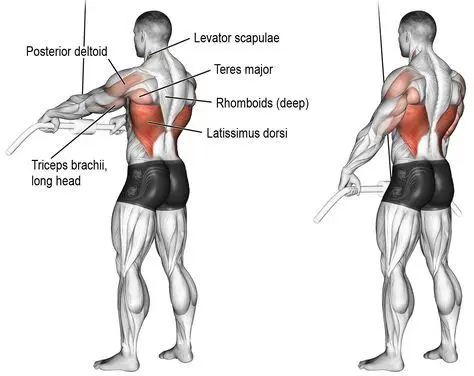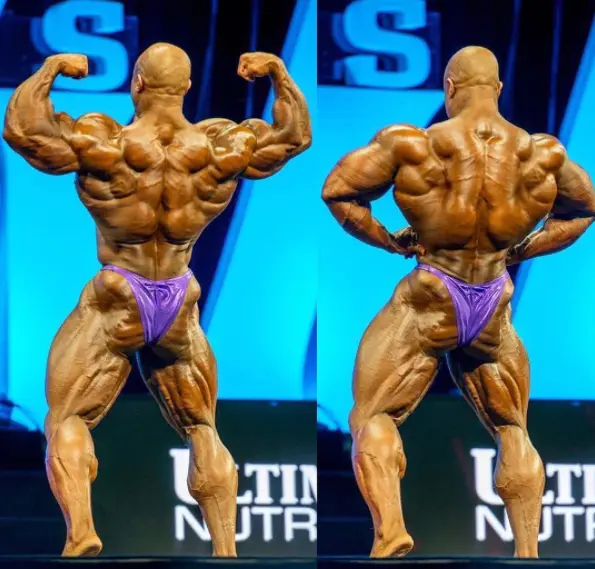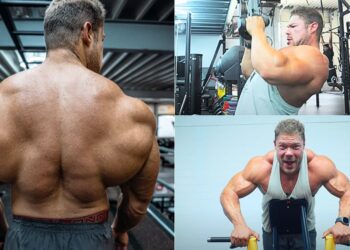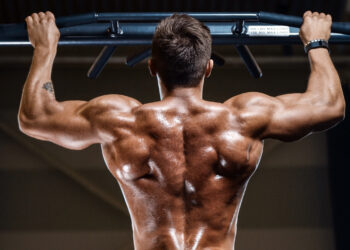When it comes to lat training, most people build their workouts around pull-ups, chin-ups, pulldowns, and rows. That’s no bad thing as these exercises are very effective back builders. However, all of these exercises have one thing in common – they are compound exercises. That means that they work, several different muscle groups at the same time, and they all involve your biceps too.
Some exercisers find that their biceps fatigue before their lats. Others don’t feel their lats working during pulldowns and rows. This can be very frustrating and will also limit your progress.
Because of these problems, if you want to develop maximal muscle size and strength, you can’t rely solely on compound exercises. For example, for legs, you will also do leg extensions and leg curls too. These are isolation exercises.
Isolation exercises involve movement at just one joint and target far fewer muscles – often only one or two. Straight arm pulldowns are one of the best ways to isolate your lats.
How to do straight arm pulldowns
Get the best possible results from this exercise by doing it correctly. Start off with light weights to master the exercise. You should be able to feel your lats working even if you are not training heavy.
1. Attach a straight bar to a high pulley machine. Grab the bar with an overhand, shoulder-width grip.
Level Up Your Fitness: Join our 💪 strong community in Fitness Volt Newsletter. Get daily inspiration, expert-backed workouts, nutrition tips, the latest in strength sports, and the support you need to reach your goals. Subscribe for free!
2. Step back and straighten your arms. Lift your chest, pull your shoulders down and back, and brace your abs tight. Push your butt back and lean forward until your torso is set to a 35 to 45-degree angle. You should feel a stretch in your lats, especially under your armpits.
3. Without bending your elbows, pull the bar down to touch your thighs. Think about driving your elbows down and back. Squeeze your lats to activate them fully. The bar should move in an arc.
4. Slowly reverse the movement. Raise the bar until you feel a deep stretch in your lats again.
You can also do this exercise with rope handles. While you won’t be able to use such a wide grip, a rope handle allows you to pull your hands back past your hips, potentially increasing lat activation. You can also do this exercise with a resistance band attached to a high anchor. Whichever option you choose, you must keep your arms straight to avoid turning this exercise into a triceps pushdown-type movement.
Muscles worked in straight arm pulldowns
Straight arm pulldowns might be an isolation exercise, but that doesn’t mean it only works your lats. There are several muscles involved in this exercise. The main ones are:
Latissimus dorsi– the large muscle located on the side of your upper back. The lats have two main functions, shoulder extension, and shoulder adduction. Straight arm pulldowns involve the shoulder extension movement. When well-developed, your lats give your upper back width and can look like wings.
Trapezius and rhomboids– your trapezius is the kite-shaped muscle of your upper back. It has three functions; shoulder girdle elevation, depression, and retraction. Pulling your shoulder blades down and back works your lower and middle trapezius, respectively. The rhomboids are small muscles located between your shoulder blades. They work with your mid traps to pull your shoulder blades back and together.
Posterior deltoids– this is your rearmost shoulder muscle. Its main job is shoulder extension. A lot of exercisers don’t train their rear deltoids enough, and that can lead to poor posture. Straight arm pulldowns are an excellent way to fix this problem.
Triceps– located on the back of your upper arm, your triceps help keep your arms straight and also aid the lats in shoulder extension. A lot of exercisers feel straight arm pulldowns in the long head of the triceps, especially the day after when delayed onset muscle soreness starts to kick in.
Core– the collective term for the muscles of the midsection, your core works hard to keep your torso rigid while you do straight arm pulldowns. You will probably feel this exercise most in your rectus abdominus, which is the main muscle at the front of your stomach.
Straight arm pulldown benefits
Straight arm pulldowns aren’t just an alternative to lat pulldowns. They also offer several additional benefits:
Improve your mind-muscle connection: The more you can feel the target muscles working during an exercise, the more effective it will be (1). This is called the mind-muscle connection. Straight arm pulldowns produce an intense contraction and stretch in your lats, which will reinforce the pathways that allow you to really feel them working.
Give your biceps a rest: Most lat exercises involve your biceps. After a few back-to-back lat exercises, your biceps may be too tired to do any more pulling-type lat exercises. Straight arm pulldowns isolate your lats and involve very little biceps activation. Even if your arms are tired, you’ll be able to keep on working your lats with this exercise.
Exercise variety: Studies have revealed that exercise variety is just as important as weight, sets, and reps for building muscle and strength (2). Adding straight arm pulldowns to your workouts means you can train your lats from an entirely new angle, and that’s good for your progress.
Improved stability during deadlifts: Straight arm pulldowns and deadlifts work your lats in very similar ways. When you deadlift, your lats extend your shoulders to keep the bar close to your body. This allows you to lift more weight. Improvements in straight arm pulldown performance are usually accompanied by better deadlifts too.
When to do straight arm pulldowns
Straight arm pulldowns are a valuable exercise that will deliver benefits whenever you do them. But, there are a few occasions when they are especially useful.
At the start of your back workout: Warm up your lats and shoulders while strengthening your mind-muscle connection by doing straight arm pulldowns at the beginning of your back workout.
Before deadlifts: Fire up your lats and increase shoulder stability by doing a few sets of straight arm pulldowns before deadlifts. This will help you keep the bar closer to your body, which will boost deadlift performance.
At the end of your back workout: Finish your lats and get a great pump with a couple of sets of high rep, lightweight straight arm pulldowns. Perfect for when your biceps are feeling tired.
If you are suffering from elbow pain: Sore elbows, especially in the biceps’ tendon, can make exercises like pulldowns, pull-ups, and rows very uncomfortable. Straight arm pulldowns are much easier on your elbows, so use them anytime you have biceps’ tendon pain.
Instead of rows if you have back pain: Seated and bent over rows can be hard on your lower back. Straight arm pulldowns work the same muscles but place much less stress on your spine. Providing you do not over-arch your lower back, straight arm pulldowns should not cause lower back pain.
The wrap-up
If you want to isolate your lats, the straight arm pulldown is the best way to do it. Some gyms have pullover machines that also isolate the lats, but these machines are pretty rare. Straight arm pulldowns are easy and convenient to do with a high cable machine, and you can even do them with a resistance band. With so many advantages and benefits to offer, this exercise deserves to be part of your back-building workouts.
More back workouts:
- 8 Best Lat Exercises For A Bigger, Stronger Back
- How To Build Your Best Back Ever With Pendlay Rows
- Strength Tips For Guarding Your Back
- Big Ramy Build His Monstrous Wide Back
References
1. Calatayud, Joaquin; Vinstrup, Jonas; Jakobsen, Markus Due; Sundstrup, Emil; Brandt, Mikkel; Jay, Kenneth; Colado, Juan Carlos; Andersen, Lars Louis (2016-03). “Importance of mind-muscle connection during progressive resistance training”. European Journal of Applied Physiology. 116 (3): 527–533. doi:10.1007/s00421-015-3305-7. ISSN 1439-6327. PMID 26700744. https://www.ncbi.nlm.nih.gov/pubmed/26700744
2. Fonseca, Rodrigo M.; Roschel, Hamilton; Tricoli, Valmor; de Souza, Eduardo O.; Wilson, Jacob M.; Laurentino, Gilberto C.; Aihara, André Y.; de Souza Leão, Alberto R.; Ugrinowitsch, Carlos (2014-11). “Changes in Exercises Are More Effective Than in Loading Schemes to Improve Muscle Strength”. The Journal of Strength & Conditioning Research. 28 (11): 3085. doi:10.1519/JSC.0000000000000539. ISSN 1064-8011. https://journals.lww.com/nsca-jscr/fulltext/2014/11000/Changes_in_Exercises_Are_More_Effective_Than_in.9.aspx










